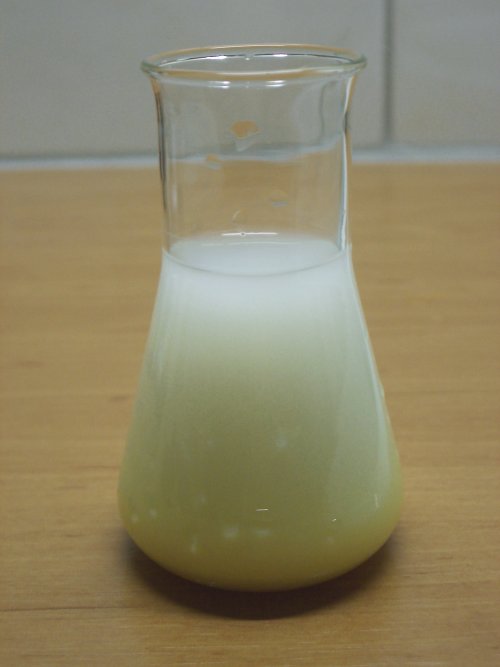


Bismuth iodo-chloro complex
In this experiment it is shown that in the presence of a large excess amount of chloride, bismuth does not form a precipitate when a small amount of iodide is added. Still, when an excess amount of iodide is present, the orange/red tetra-iodo complex of bismuth is formed.
Formation of chloro-iodo complex from BiCl4–
![]() Dissolve
some (basic) bismuth nitrate in dilute hydrochloric acid. This should yield a
clear and colorless solution. If too much bismuth nitrate is used and the
solution is somewhat turbid, then add a little more acid. Bismuth is very easily
hydrolysed to insoluble basic salts, so it may be necessary to use quite some
acid to obtain a clear solution.
Dissolve
some (basic) bismuth nitrate in dilute hydrochloric acid. This should yield a
clear and colorless solution. If too much bismuth nitrate is used and the
solution is somewhat turbid, then add a little more acid. Bismuth is very easily
hydrolysed to insoluble basic salts, so it may be necessary to use quite some
acid to obtain a clear solution.
![]() Carefully add a small amount of a solution of potassium iodide to this solution.
This results in formation of a clear yellow solution with an orange layer on top
of it and still some colorless liquid at the bottom. This is shown in the left
picture below.
Carefully add a small amount of a solution of potassium iodide to this solution.
This results in formation of a clear yellow solution with an orange layer on top
of it and still some colorless liquid at the bottom. This is shown in the left
picture below.
![]() Shake the test tube. This results in formation of an
intensely colored yellow solution. This is shown in the second picture from the
left.
Shake the test tube. This results in formation of an
intensely colored yellow solution. This is shown in the second picture from the
left.
![]() Carefully add a little more solution of potassium iodide.
This again results in formation of an orange layer on top of a yellow liquid.
This is shown in the second picture from the right.
Carefully add a little more solution of potassium iodide.
This again results in formation of an orange layer on top of a yellow liquid.
This is shown in the second picture from the right.
![]() Finally, shake the test tube again. Now a yellow solution is
obtained, but it is a little more orange/yellow than the previous yellow
solution. This is shown in the rightmost picture.
Finally, shake the test tube again. Now a yellow solution is
obtained, but it is a little more orange/yellow than the previous yellow
solution. This is shown in the rightmost picture.

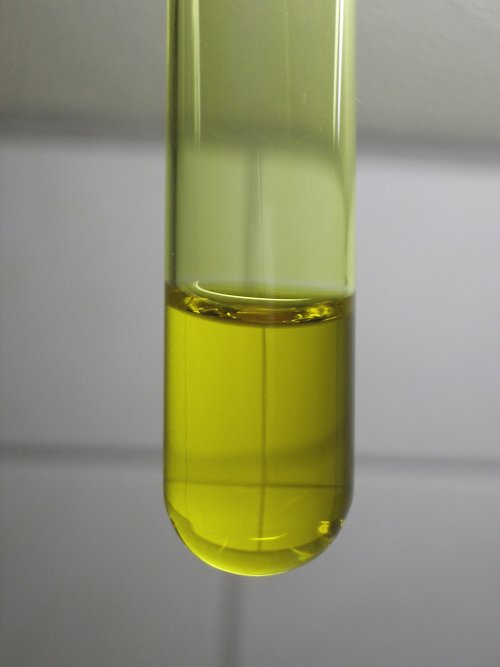
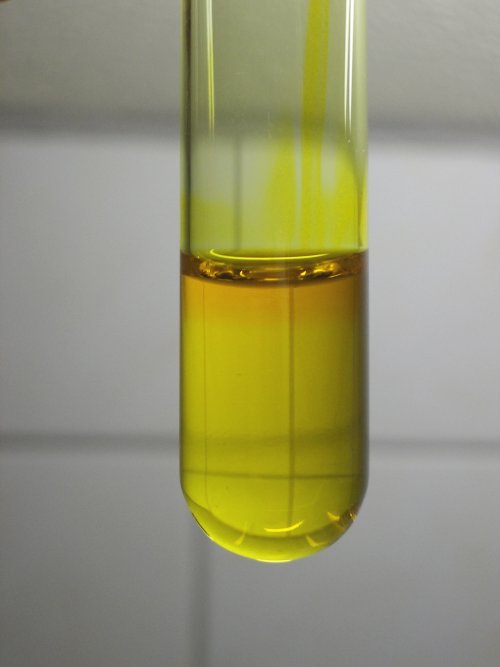
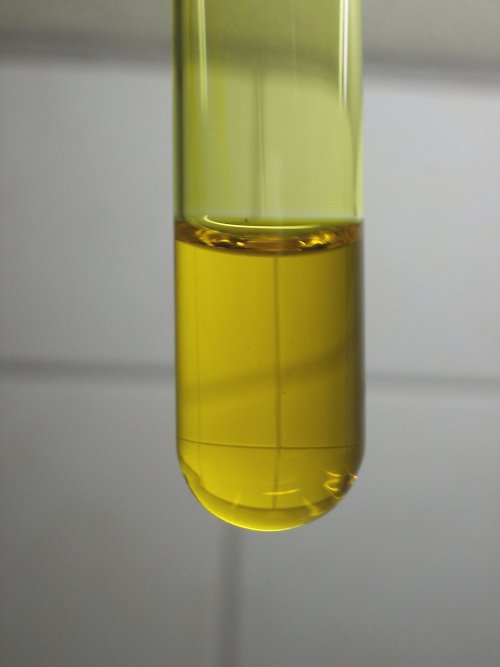
The orange compound is the tetra-iodo-bismuthate (III) complex, BiI4–. The yellow compound is a chloro-iodo-bismuth complex, probably it can be written as BiCl4-nIn–.
The chloride is essential for the formation of the yellow compound. If no chloride is present and only a small amount of iodide is present, then a precipitate of black BiI3 is formed, as is shown in experiment 1.
On dilution with water, the yellow compound is not stable. It hydrolyses very easily. At the left picture below, one can see formation of a dark grey precipitate on careful addition of some water. On further dilution, a light grey precipitate is formed, as is shown in the right picture. On really strong dilution, a white precipitate is formed. This white precipitate was formed, by adding a small amount of the contents of the test tube to an erlenmeyer which contains approximately 50 ml of water.
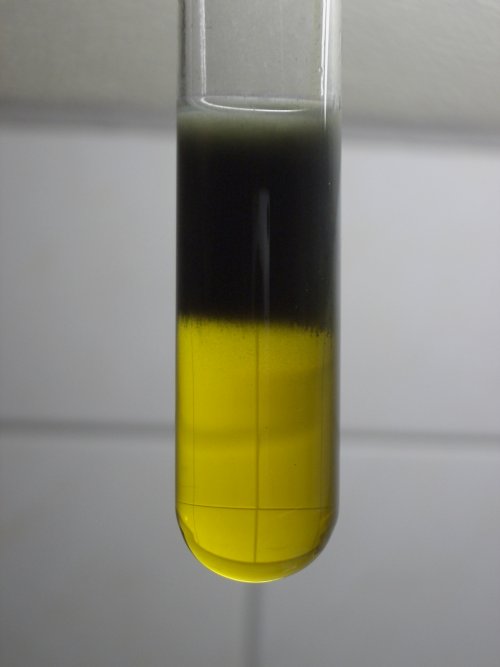
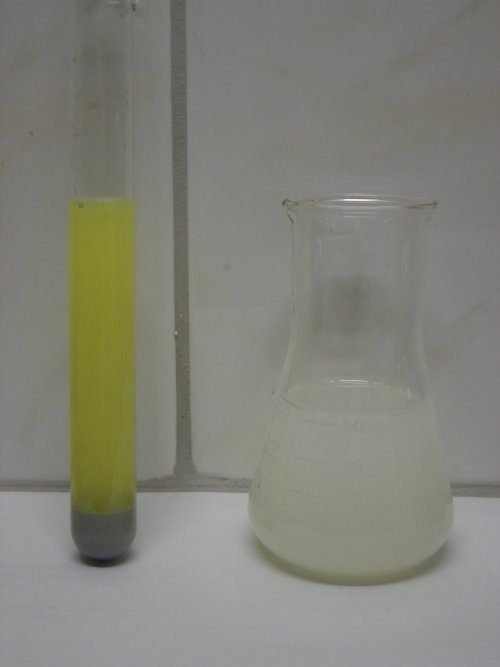
The black precipitate is bismuth (III) iodide. It becomes grey, due to hydrolysis in which some basic bismuth salt or hydrous bismuth oxide is formed. The more dilute, the more of the hydrous bismuth oxide is formed. This is shown in the right picture, which shows a test tube with a grey precipitate at the bottom. This grey precipitate probably is a mixture of bismuth iodide and hydrolysed bismuth in a basic salt.
Formation of chloro-iodo complex from BiI3
In this experiment, first a precipitate of bismuth iodide is prepared. By adding some sodium chloride to this, it can be shown that the bismuth iodide precipitate dissolves and forms a chloro-iodo complex.
The pictures below show how this experiment can be done.
![]() Dissolve some (basic) bismuth nitrate in dilute nitric
acid.
Dissolve some (basic) bismuth nitrate in dilute nitric
acid.
![]() To the clear and colorless solution add a small amount
of a solution of potassium iodide. A black precipitate is formed. This is shown
in the picture on the left. This picture shows a little yellow liquid, sticking
to the glass. This is where the solution of potassium iodide flowed into the
liquid. Locally, at that place, there is an excess amount of iodide and the
tetra-iodo complex of bismuth is formed.
To the clear and colorless solution add a small amount
of a solution of potassium iodide. A black precipitate is formed. This is shown
in the picture on the left. This picture shows a little yellow liquid, sticking
to the glass. This is where the solution of potassium iodide flowed into the
liquid. Locally, at that place, there is an excess amount of iodide and the
tetra-iodo complex of bismuth is formed.
![]() To the liquid with precipitate, a little more solution
of potassium iodide is added. This results in formation of a lot of black
precipitate. This is shown in the middle picture.
To the liquid with precipitate, a little more solution
of potassium iodide is added. This results in formation of a lot of black
precipitate. This is shown in the middle picture.
![]() Finally, add a spatula full of sodium chloride to the test tube with the large
amount of black precipitate. Shake the liquid for a while, until all salt has
dissolved. While this dissolves, the black precipitate also dissolves and a
bright yellow liquid is formed. This liquid is shown in the right picture.
Finally, add a spatula full of sodium chloride to the test tube with the large
amount of black precipitate. Shake the liquid for a while, until all salt has
dissolved. While this dissolves, the black precipitate also dissolves and a
bright yellow liquid is formed. This liquid is shown in the right picture.
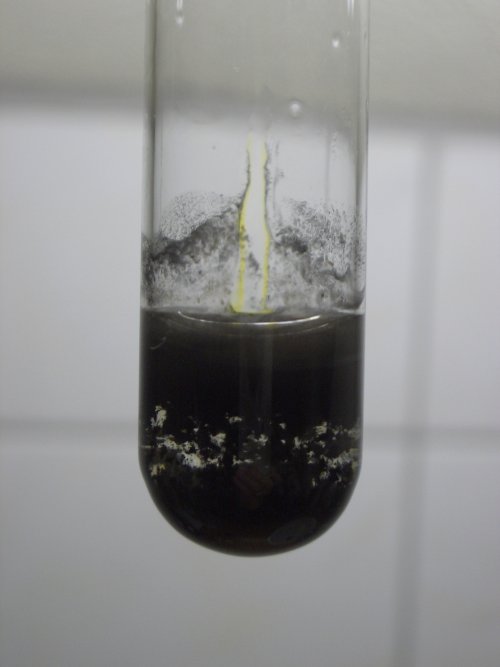
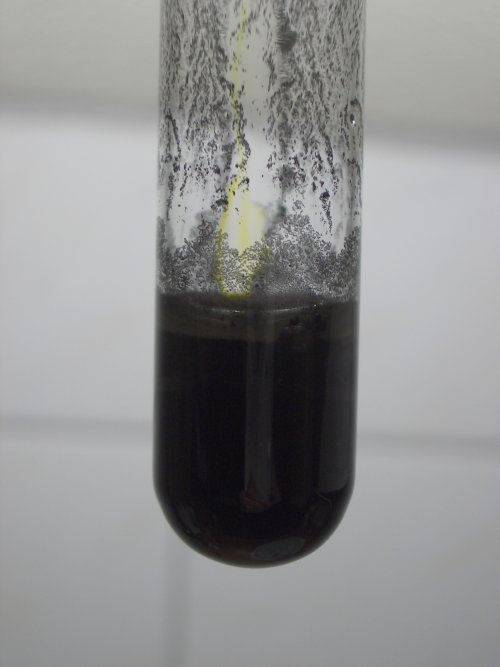
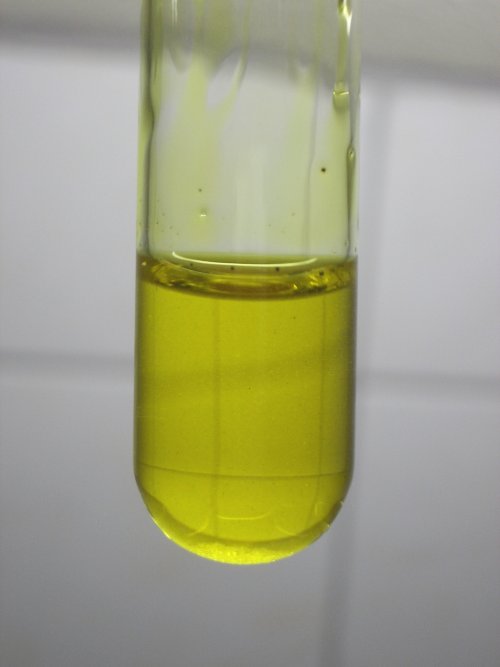
The yellow liquid can be hydrolysed easily and the product of hydrolysis is a white solid. This white solid is a basic bismuth salt. Is this white precipitate hydrous BiOCl or BiOI?
